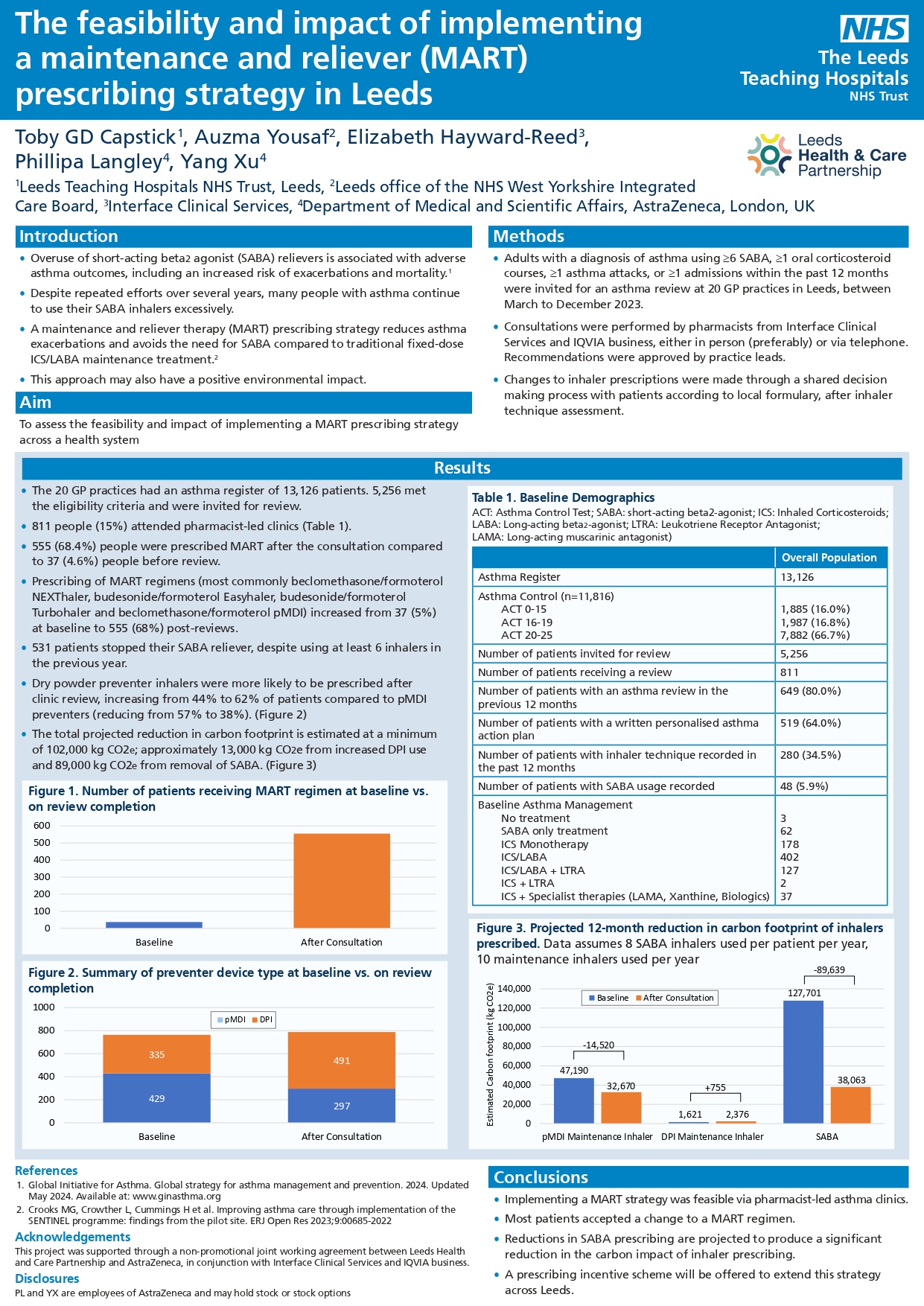The feasibility and impact of implementing a maintenance and reliever (MART) prescribing strategy in Leeds (ID 532)
Leeds Teaching Hospitals NHS Trust
Abstract
Introduction:
Overuse of short-acting beta2 agonist (SABA) relievers is associated with adverse asthma outcomes, but remains commonplace. A maintenance and reliever therapy (MART) prescribing strategy reduces asthma exacerbations and avoids the need for SABA compared to traditional fixed-dose ICS/LABA maintenance treatment.[1] This approach may also have environmental benefits.
Aim:
To assess the feasibility and impact of implementing a MART prescribing strategy across a health system
Methods:
From March to December 2023, across 20 Leeds GP practices, adults with a diagnosis of asthma using ≥6 SABA, ≥1 oral corticosteroid courses, ≥1 asthma attacks, or ≥1 admissions within the past 12 months were invited for an asthma review supported by pharmacists from Interface Clinical Services and IQVIA business.
Results:
811 of 5,256 invited patients (15%) attended pharmacist-led clinics. Prescribing of MART regimens (most commonly beclomethasone/formoterol NEXThaler, budesonide/formoterol Easyhaler, budesonide/formoterol Turbohaler and beclomethasone/formoterol pMDI) increased from 37 (5%) at baseline to 555 (68%) post-reviews.
531 patients stopped their SABA reliever, despite using at least 6 inhalers in the previous year. Dry powder preventer inhalers were more likely to be prescribed after clinic review, increasing from 44% to 62% of patients compared to pMDI preventers (reducing from 57% to 38%).
The total projected reduction in carbon footprint is estimated at a minimum of 102,000 kg CO2e; 13,000 kg CO2e from increased DPI use and 89,000 kg CO2e from removal of SABA.
Conclusions:
Implementing a MART strategy was feasible via pharmacist-led asthma clinics, leading to increased MART, decreased SABA prescribing, and a reduction in projected carbon impact of inhaler prescribing. A prescribing incentive scheme will be offered to extend this strategy across Leeds.
1. Crooks MG et al. ERJ Open Res 2023;9:00685-2022
Funding: This project was supported through a non-promotional joint working agreement between Leeds Health and Care Partnership and AstraZeneca, in conjunction with Interface Clinical Services and IQVIA business.
Conflicts of interest: TGDC has received non-financial support from Chiesi, GSK and Napp for attendance at the European Respiratory Society (ERS) conference. His employer has received payment from AstraZeneca, Chiesi, GSK, Novartis, Boehringer Ingelheim, Orion, and Insmed for his participation in advisory boards and providing teaching sessions. PL and YX are employees of AstraZeneca.
The conference has been instigated and organised by PCRS. We are grateful to sponsors and exhibitors who have contributed funding towards this event in return for exhibition space. Neither sponsors or exhibitors have had any input into the agenda or the selection of speakers with the exception of any sponsored satellite symposia which are clearly indicated. View the full list of sponsors.
